#(that's why catra compells me.... talk about a character who makes the worst decision at every point. she's just like me fr fr)
Text
3 Examples of Racial Bias in Animation Storytelling

It’s not hard to grasp that a white person, while not explicitly or consciously racist in the sense we might usually imagine, is still inherently racially biased because they benefit from and grow up used to white supremacy.” - Scottishwobbly, Tumblr
This is nothing new. This is something POC (People of Color) have been talking about in separate fandoms. Nevertheless, it needs to be acknowledged by those unaware.
This article is not made to say that some of the animations that I will use as examples are bad. But in the hopes that we, as consumers and creators, will do better in the future in handling characters that are POC.
Most often, racial bias in storytelling is when the narrative treats white or light skin toned characters better than darker skin toned characters. The darker skin toned characters are often POC-coded or actual POC.
White creators often do not notice their racial bias in their storytelling as they benefit from and grow up with white privileges and white supremacy. This can also apply to light-skinned POC who have light skin priviliges.
Some of us don’t often see it but real people who relate to the characters of color do. Especially when it reflects from their experiences with racial bias, microaggressions, colorism and flat out racism.
So when they speak up, it’s important to listen to them to unlearn the racial bias we may have in ourselves.
I will be emphasizing “the narrative” for I am criticizing how the story treats its dark-skinned characters and not because I am criticizing the characters themselves.
This article is critiqued by @visibilityofcolor as a sensitivity reader once and then additions were made before publishing. If you’re looking for a Black sensitivity reader, you can contact her.
This article is a 14-minute read at average speed so buckle up. Unless you want to skip to your show mentioned below. External Tumblr Resources will be put in the reblog.
Here are three examples that I was made aware of.
Example #1: The Narrative Treats the Light-Skinned Character at the Expense of the Dark-Skinned Character

Steven Universe was one of the animations that pushed lgbt+ representation in cartoon media. However, there are narratives here and there that showed racial bias.
SU creator Rebecca Sugar was raised with "Jewish sensibilities" and both siblings observe the lighting of Hanukkah candles with their parents through Skype.[1] Rebecca Sugar also talked about being non-binary.[2]
But as a white person, she (and the rest of the SU crew) is not aware of the inherently biased values from growing up and benefiting from white privilege.
One example is the human zoo. There are people that have spoken up about this such as @jellyfax of Tumblr who pointed out that the Crewniverse mishandled a loaded topic and reinforced a white colonist propaganda where the captive humans of mostly black/brown people are naive, docile and childlike in order to subjugate the people that they colonized. .
What I’m here is how a character of color from the main cast is more obligated to the lighter-skinned character.
In the episode, Friend Ship, one fan had spoken out about how Garnet, who had been validly angry at Pearl, was compelled by a dangerous situation to forgive Pearl. Garnet is a Black-coded character. While Pearl is a light-skinned character.

Garnet was mad at Pearl for tricking her into always fusing with her. Then they were trapped in a chamber that was going to crush them. In this situation, they have to fuse in order to save themselves but Garnet refuses to because she was still angry at her.
In the end, they were forced to talk it out, for Garnet to understand Pearl’s reason for wanting to fuse with her and everything worked out well.
The narrative focused so much on Pearl’s self-worth issues at the expense of Garnet’s right to be angry.
Yes, it showed that Pearl is trying her best to make up for it but Garnet should have been allowed to work at her own anger at her own pace instead of being obligated to consider Pearl’s feelings over her own.
I wouldn’t have noticed it until someone had mentioned it. Because it was never my experience.
But it’s there, continuing the message that it’s okay to put the emotional labor on Black people and disregard their own feelings for the sake of the non-Black people who have hurt them -particularly light-skinned women.
White Fragility and Being Silenced White Woman Tears
Again, racial bias in animation storytelling is often not intentional because white creators do not experience it due to white privilege.
Without meaning to, that scene alone shows Garnet as the Angry Black woman trope that is ungrateful and rude to Pearl who then ends up in tears. Without meaning to, Pearl with her light skin, became the tearful white girl trope that had to be sympathized over.
The Angry Black Woman trope is a combination of the worst negative stereotypes of a Black woman: overly aggressive, domineering, emasculating, loud, disagreeable and uppity.[13]
The Tearful white girl trope comes from the combination of the stereotypes of white women being morally upstanding and delicate and therefore should be protected.[13]
Which, unfortunately, many white women have taken advantage of.
These two tropes are harmful to WOC (Women of Color) because they experience the "weary weaponizing of white women's tears". This tactic employed by many white women incites sympathy and avoids accountability for their actions, turning the tables to their accuser and forcing their accuser to understand them instead.

(Image by Виктория Бородинова from Pixabay)
In "Weapon of lass destruction: The tears of a white woman", Author Shay described that white tears turns a white woman into the priority of whatever space she's in. "It doesn't matter if you're right, once her tears are activated, you cease to exist." [11]
White woman tears have gotten Black people beaten and lynched such as Emmett Till. Carolyn Bryant who had accused 14 year old Emmett Till of sexually harassing her in 1955, admitted she lied about those claims years later in 2007.[15]
In Awesomely Luvvie's "About the Weary Weaponizing of White Women Tears", she states that the innocent white woman is a caricature many subconsciously embrace because it hides them from consequences. [10]
In The Guardian’s article, "How White Women Use Strategic Tears to Silence Women of Colour", Ruby Hamad shares her experience:
"Often, when I have attempted to speak to or confront a white woman about something she has said or done that has impacted me adversely, I am met with tearful denials and indignant accusations that I am hurting her. My confidence diminished and second-guessing myself, I either flare up in frustration at not being heard (which only seems to prove her point) or I back down immediately, apologising and consoling the very person causing me harm."[4]
This is not to say that all crying white women are insincere. But as activist Rachel Cargle said:
“I refuse to listen to white women cry about something. When women have come up to me crying, I say, ‘Let me know when you feel a little better, then maybe we can talk.’”[3]
One of the most quoted words in “White Fragility: Why It’s So Hard for White People to Talk About Racism.” is this:
“It is white people’s responsibility to be less fragile; people of color don’t need to twist themselves into knots trying to navigate us as painlessly as possible.”[3]
When white women cry in defense, instead of taking accountability, People of Color are then gaslighted into thinking they’re the bad guy. This is emotional abuse and a manipulation tactic.
People of Color shouldn’t have to bend backwards to accommodate discomfited white or light-skinned people who have hurt them.
How She-Ra and the Princesses of Power (SPOP) Did It Right
Despite SPOP having good lgbtq+ representations, there are other biases in the show. Such as Mara, a WOC whose only purpose was to sacrifice herself for the white protagonist. There was also the insensitive joke in their stream regarding Bow’s sibling that perpetuated an Anti-Black stereotype which Noelle Stevenson has apologized for.[14]
But the scene I have encountered where the Black character was validly angry and his feelings were treated well by the narrative, came from SPOP.
Bow, a black character, was validly angry at Glimmer, a lighter skinned character. Glimmer made a lot of bad decisions, one of them was using Adora and their friends as bait, without their knowledge, to lure out and capture Catra.
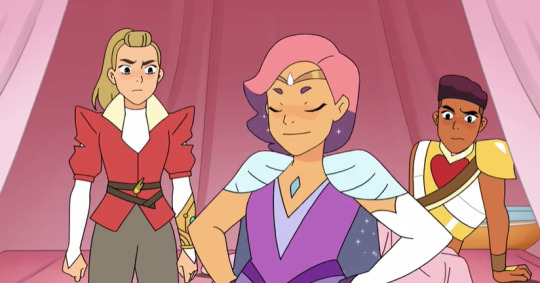
Glimmer tearfully apologized in Season 5, Episode 4. Adora readily forgave her. But Bow didn't.
They faced dangers along the way but the story didn't put them in a dangerous situation where Bow has to forgive Glimmer in order to get out of it.
This was Glimmer's words of apology:
"Look, I know you're still mad at me. Maybe you'll be mad at me for a really long time. I deserved it. And maybe... maybe we'll never be friends like we used to be. But I'm not going to stop trying to make it better. I made a mistake with the heart of Etheria. I should've listened to you and I'm sorry. You get to be mad. For as long as you need to be. But I'm not going anywhere. And when you're ready, I'll be here."

In short, Bow was allowed to take the time to be mad and not just get over it for someone else’s sake. The story validates his feelings and he was allowed to take his own pace. That is emotional respect the story gave to him.
Example #2: The Narrative Gives Better Endings or Portrayals to Colonizers than Their Victims
Avatar: The Last Airbender has handled dark themes well such as genocide, war, PTSD, disability and redemption with great worldbuilding.
However, I never noticed the racial bias in ATLA until people spoke up of the double standards in ATLA’s treatment of light-skinned colonizers compared to their dark-skinned victims-turned-villains.

The characters in question -Iroh, Azula, Jet and Hama- are all flawed and well-rounded in a believable way. But how the narrative treats them is unequal.
General Iroh is an ex-colonizer who gets to redeem himself and not answer for his past war crimes, living a peaceful life as a tea shop owner. The only reason Iroh changed was when he was personally affected by the negativity of their military subjugation -his son’s death. It wasn’t the harm of the Fire nation ravaging Earth kingdom villages or cities and affecting millions of people that opened his eyes.
Azula, the tyrannical daughter, had closure of her mother's rejection when she was a child and was able to escape imprisonment.
Jet and Hama, victims of colonization who have done bad things, did not get similar conclusions to their stories OR compensation for what they have gone through from the Fire Nation's colonization.
Jet was given a second chance but was arrested for trying to expose Zuko and Iroh being firebenders -firebenders who were their enemies for conquering their villages. Then he died from the injuries of the person who had brainwashed and mind-controlled him.
Hama was imprisoned for life.
Compared to the sins of the light-skinned colonizers, the narrative didn’t give Jet and Hama the development where they could heal from their trauma, receive compensation for what happened to them and really have a chance in life.
The dark-skinned victims of colonization just became a lesson to the viewers how they shouldn’t hold grudges for being colonized. The end. They have received consequences for their actions but there is no continuation to their stories after that.
It almost seems like the narrative is saying that because they have harmed colonizers who have no part in their trauma (and in Jet’s case, some Earth kingdom villagers), they are therefore unworthy to be given an actual chance in life.
While Azula and Iroh, who have actively participated in conquering, colonizing and attacking the Earth Kingdom itself, were.
Someone once said that if indigenous people have control over Hama’s story, it would have been done differently. But the ATLA crew are white, non-indigenous people who prioritized redeeming colonizers instead.
The narrative has also affected how the ATLA fandom thinks. If most fans are asked who they would want to be redeemed, the popular option would be Azula over Jet or Hama.
Once again, I don’t think the ATLA crew noticed it due to their racial bias. But still, the harm is done and the racially biased message is continued:
The colonizers and their descendants don’t have to make amends for the colonizers’ crimes. Or if they do, only lightly since it’s in the past (no matter how recent that past is).
The colonized who rebel will tend to hurt innocent people and then get a grisly end for getting in way over their heads.
I would venture as far as to say that the narrative may have the added subconscious desire to quiet their white anxiety on the vengeance of the colonized. As I have learned when writing about Vodou stereotypes and how they have stemmed from the history of white anxiety of Black vengeance, of Black fetishization and of dissolution of the white race through intermarriages.
In @visibilityofcolor’s blog, someone asked:
“So I saw some of the really heated debates on here and on twitter about how if Iroh and Azula can be portrayed sympathetically despite their actions then characters like Jet and Hama should've been given a chance too. Do you think that the writers understood the implications of only redeeming characters from the colonizer/fascist nation but not giving the characters who suffered because of their fascism a second chance too?”
To which VisibilityOfColor replied:
“No, because at the end of the day, the writers are white. When it comes to stuff like this, it’s no surprise when we see white writers redeem problematic characters before they actually redeem victims of those racist problematic characters. For instance, Dave Filioni, who worked on both avatar and star wars rebels, did the same thing when redeeming agent kallus who was an soldiers in the imperial army and took credit for a genocide. where as victims of the empire were still painted in negative lights. i really don’t think they understand.
They have this ‘be the better person’ view on things, which is what a lot of white people tend to emulate when it comes to people of color standing up to their oppressors. and unfortunately, these are ideas passed on to children, esp minorities. that they should forgive people and communities who hurt them and ‘be the better person’. this is why white ppl don’t need to write narratives for people of color.”
Example #3: The Narrative Favors the Light Skinned Character Than Dark Skinned Character in Similar Situations

I would like to reiterate that racial bias in storytelling is often not intentional. I am not saying the creators and the people who support them are bad people. No.
However, I encourage that once a racial bias is made known in our work, it is our responsibility to change them to stop the perpetuation of its harmful message.
Hazbin Hotel is a popular cartoon with whimsical designs and its concept opens the conversation about redemption. The creator, Vivziepop may not have noticed the racial bias in her cartoon as a white Latina [5] that grew up with and benefits from white privileges, along with the Hazbin crew.
In the Youtbe video, "Hazbin Hotel - How Art took over Writing", Staxlotl states:
“I understand that there was a lot of time and effort put into this pilot, almost three years worth of effort. But I think most of that time was spent into the art and visuals when it should’ve gone into polishing the writing in the characters.”[6]
Once again, I’m not here to critique the characters but how the narrative treats its dark-skinned characters.
The story treats Charlie, the white-skinned, “Disney-esque” protagonist princess differently from how it treats Vaggie, the dark-skinned, more outspoken and protective Latina girlfriend of Charlie who supports the princess’ cause.
In its pilot episode, both girls experience humiliation. While Charlie is portrayed by the story as someone the viewers have to feel sorry for...

...Vaggie is portrayed in her humiliation as the butt of the joke for the viewers.
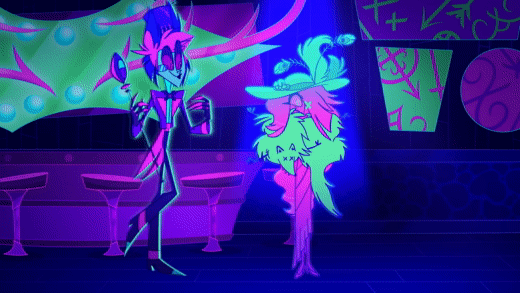
While they both didn’t like what Angel Dust did, Charlie was sympathized over in the narrative as a moment...
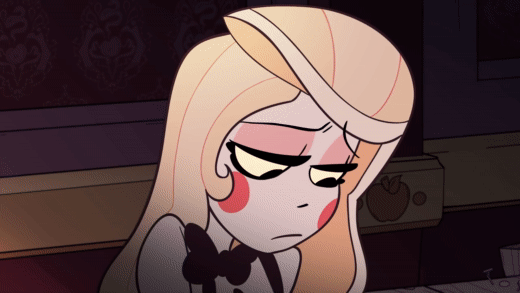
...while Vaggie’s angry but valid callouts were dismissed and ignored as part of the comedy.
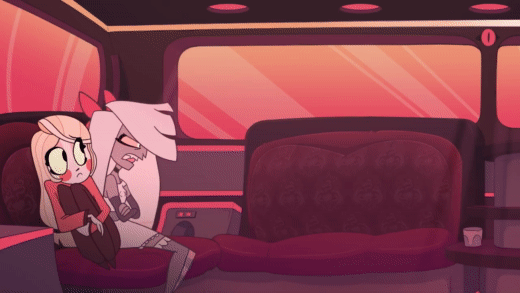
While Charlie was someone that needs to be protected in the narrative...
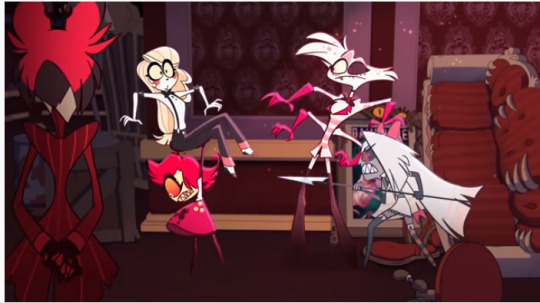
...Vaggie is left to fend for herself.

Again, I don’t think the creators noticed the racial bias of their cartoon. However, this racial bias is reflected in the harmful perceptions that dark-skinned women, particularly Black women and Black girls, are more mature, tougher and need less protection at a young age.[7]
This adultification bias perceives them as challenging authority when they express strong or contrary views and are then given harsher discipline than white girls who misbehave.[8] And this continues when they grow up.
In a 2017 study, Black women and girls aged 12-60 years old confirmed they are treated harsher by their white peers and are accused of being aggressive when they would defend themselves or explain their point of view to authority figures.[8]
This bias also coincides with the Spicy Latina trope of a brown-skinned, hot-blooded, quick-tempered and passionate woman.
Everyday Feminism described this trope as "Although objects of desire for many, the spicy Latina may have too much personality to handle. So much so that she is often viewed as domineering or emasculating." [16]
Sounds familiar? (Look at Angry Black Woman trope above.)
Why is it that a light-skinned character, Charlie, is allowed to be vulnerable and be sympathized while the dark-skinned Latina character, Vaggie, is mocked, dismissed and expected to tough it out?
Severina Ware had to remind the world in her article that relates to the bias against dark skinned characters:
“Black women are not offered the protection and gentleness of our white counterparts. We are not given permission to be soft and delicate. We are required to exhibit strength and fortitude not only because our lives depend on it, but because so many others depend on us. Black women should not be charged with the responsibility of saving everyone when nobody is here to save us.”[12]
As @cullenvhenan of Tumblr has said in her post:
“if you're a white creator and your brown/black characters are always sassy, reckless, aggressive or cold and your white characters are always soft, demure, shy and introverted you should think about maybe why you did that”

(Image above from Iowa Law Reviews’ “Aggressive Encounters & White Fragility: Deconstructing the Trope of the Angry Black Woman”)
Detecting Your Own Racial Bias
It would be hard. No matter how much you edit and create, you may miss it because it was never your experience.
So how do we prevent our racial bias from creeping into our creations?
Listen to POC and their feedback.
As @charishjb from Instagram has shared, here is one of the things that we can do (tumblr link here) [9]:

Consider POC voices. Listen to their experiences. Hire sensitivity POC readers. Put multiple POC voices in positions of leadership in creative projects.
Then we can stop the racial bias that perpetuates again and again in the media. I hope for that future.
#racial bias#racism#colorism#animation#steven universe#su#pearl#garnet#atla#azula#general iroh#jet#hama#hazbin hotel#hazbin vaggie#lynching mention#lynching tw#writeblr#artblr
795 notes
·
View notes
Note
How do you feel about Catra, Shadow Weaver, and Hordak? I know you said you find SW interesting but like on a scale how redeemable do you think these characters are. Ive seen a lot of infighting in the fandom cause some people love one and hate another and I just figured you would approach the topic nicely
Oh damn, happy to respond! (Under the cut because I don’t know how to shut up.)
I think I’ve seen some of the posts that you’re talking about, and my friend did tell me that there was apparently tension between Entrapdak and Catradora shippers for that very reason. Still, I should start off by saying that the only character who is probably completely irredeemable is Horde Prime. And knowing this show, they’ll find a way to humanize even him if they are so inclined. The great thing about She-Ra is that there aren’t so much heroes and villains as there are complicated people. Undertale is the same way. This might sound weird, but I legitimately hope Horde Prime does get humanized, because otherwise it’s just way too easy for all of the characters to band together and take him out for a happy ending. This show has never had a character that was pure evil before, know what I mean?
With that in mind...let’s talk about Hordak.
I know, I know...before Horde Prime was known to us...Hordak basically was Horde Prime. That’s the role he played in the show, and it’s not like he isn’t guilty of countless war crimes. He’s a conqueror, and yeah, conquerors should not get off scot-free. But...Hordak is also clearly an abuse victim. That doesn’t excuse him from what he’s done, but I can’t just ignore it. He was so eager to get back to Horde Prime, so determined to please him and prove himself to his “big brother.” and the moment that they’re reunited? We see what a nightmare it is for Hordak, see him get mentally violated and brain-washed. This can’t be the first time it’s happened, and yet all Hordak wanted was to return to Horde Prime. This man is so sheltered and so emotionally stunted in relationships, that I doubt he understands the full ramifications of his actions. He certainly doesn’t understand that he’s in abusive relationship. Hordak is just doing what he knows. He could learn better, if he learns to accept what a monster Horde Prime is. (But first he’ll need to break from the conditioning.)
I genuinely like how it took Entrapta, a character who isn’t really loyal to either side, to reach out to him and help him understand how it feels for a person to care about him, and not fear him even when he tries to be intimidating. And whether or not you ship them, (I do, I admit it) Hordak clearly has feelings for her and that guides his character in Season 4. I don’t know if Adora and the others will agree to take him in...but Entrapta will remember the bond they had. I just feel so bad for this guy, even if he has killed countless innocents. My philosophy about redeeming villains is very much a pragmatic one...will Hordak’s redemption spit in the face of all his victims? Perhaps. Will it bring them back to life? No. But neither will executing him or throwing him in prison. If he can heal, if he can learn better, and do better...why should we waste that growth? Why shouldn’t he be allowed the chance to make up for what he’s done? It seems to me like there is everything to be gained, and nothing to be lost, in letting him redeem himself.
Of course, there are many types of crimes...let’s move on to Shadow Weaver.
....She’s a child abuser. Plain and simple. That is a hard pill to swallow, that is a very difficult thing for me to look past. I don’t think I can do it. The way she treated Catra, the way it’s ruined Catra and Adora’s relationship...it’s unspeakable. She manipulates Catra one last time and leaves her high and dry so she can escape and go to Bright Moon...whereupon, she starts grooming Glimmer the same way she did Micah. I know it seems silly to be more upset about child abuse than what probably amounts to genocide on Hordak’s part...but part of it is how relatable the crimes are. There’s a reason most Harry Potter fans hate Umbridge more than Voldemort. Most people don’t know a mass-murderer, and excusing a character like Hordak won’t change their perspective on murder being wrong. But plenty of people might know an abuser, and abusers thrive on a culture that blames victims and downplays the effects of abuse, or otherwise excuses those responsible. We need to get better about sending the message that abuse is real, and wrong. But the great thing about She-Ra is that it depicts the cycle, from Shadow Weaver to Catra. If Catra is redeemable, why not Shadow Weaver?
And here’s the thing...I’m not saying she isn’t redeemable. Just that I don’t expect this show to fully redeem her, and I’m 100% behind that outcome. She could be allowed to live in peace with the other characters, her victims might forgive or at least tolerate her. (Especially if she wins over Micah again.) But even if I find her genuinely compelling...I’m not seeing too many outcomes where she would deserve this mercy. Shadow Weaver has done terrible, selfish things, and her only loyalties seem to lie with knowledge and power. She’s completely unrepentant, and while she acknowledges that she was “hard on Catra” she also refuses to apologize. Shadow Weaver strikes me very much as a kind of “no regrets” type of person. But she also has a fascination with power, and any time she sees a youngin’ with a lot of potential, (Micah, Adora) she seeks to train them. Considering how poor her record is...she needs to stop doing this. I might be inclined to forgive Shadow Weaver, if she acknowledges her own short-comings, apologizes to the people she’s hurt, and realizes that looking after children is not something she’s cut out to do.
Finally, there’s Catra.
In many ways, she’s my favorite character. (Though I also might go with Glimmer.) The story is largely centered around Catra’s journey alongside Adora’s...she might as well be a secondary protagonist. What’s more, she’s a character who we basically know is going to get redeemed, Noelle has all but told us that it’s going to happen. I’m fine with her getting redeemed but so help me god if she dies in the process....if any aspiring writers are reading this, please stop killing your villains to complete their redemption arcs. Let them enjoy being redeemed. Please. Anyway, where was I? Ah that’s right, Catra. There have been times that I was beyond frustrated with her because she was purposefully choosing to be “evil” as Double Trouble lampshades at the end of Season 4. By the time she opened up the Portal, after sentencing Entrapta to die, nearly dooming the entire world, causing Angela’s death, and despite it all she still blamed Adora even though she only did all of this because she wanted to beat Adora...yeah, I was really running out of patience for Catra. And even now, I can’t really bring myself to agree with the fans as they draw parallels between Catra opening the Portal and Glimmer activating the Heart of Etheria. I’m sure this was intentional, too. The echoing of two characters dooming everyone through an impulsive, reckless choice. However...as I said, Catra was pretty much going off the deep end when she opened the Portal. She just wanted to stick it to Adora. I realize I may be biased as a Glimmer stan, but Glimmer was at least trying to defeat the Horde. Her intentions, however misguided, were noble. She thought she was doing the right thing. Catra just didn’t care.
All this, and you might think I’m Anti-Catra, that I await her inevitable redemption with gritted teeth. But that’s not true at all. Catra is a character who is her own worst enemy, and characters like that have a knack for winning my sympathy. She continues to dig herself into a deeper hole and hurts those around her in the process. Part of her journey is realizing that and presumably working to change it. This is why I love how distant she becomes from Lonnie and the others in S4. Why I love Double Trouble betraying and completely shutting her down with their monologue about her. Why I cheered louder than you can imagine at “You’re a bad friend.” Because it was such an amazing crossroads in the development of both Scorpia and Catra’s characters. To be clear, I love these moments not because I dislike Catra, but because I genuinely like her as a character, and Catra as a “good guy” is a lot of fun. I don’t know how many people remember what it was like in the first episode when Catra and Adora were still besties, but it was just generally fun. I miss that dynamic. I want Catra to learn from her mistakes. Because I rambled on about the terrible things Shadow Weaver has done, and onscreen those were primarily done to Catra. She’s a character that I am rooting for one-hundred percent. A character who is almost a deconstruction of the tired writing trope “They had a hard childhood, and now that you know that, they are redeemed.” Catra turns that on it’s head. “Promise” is one of my favorite episodes for this very reason. Few moments have gotten me as choked up as Adora saying that she thought Catra didn’t care about being Force Captain, and Catra exploding with “Well I was lying, obviously!” It was a reveal that I genuinely didn’t see coming, but it makes so much sense, and demonstrates how much Catra has sacrificed for Adora and how much that weighs on her every time she makes a villainous decision.
TL;DR: I am one-hundred percent on board with Catra and Hordak redemption, and tentatively on board with Shadow Weaver redemption.
7 notes
·
View notes